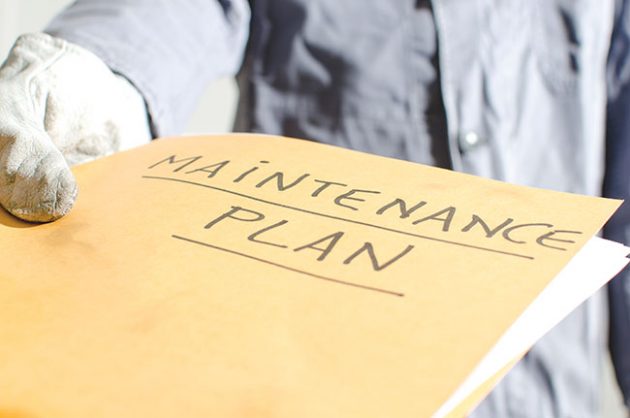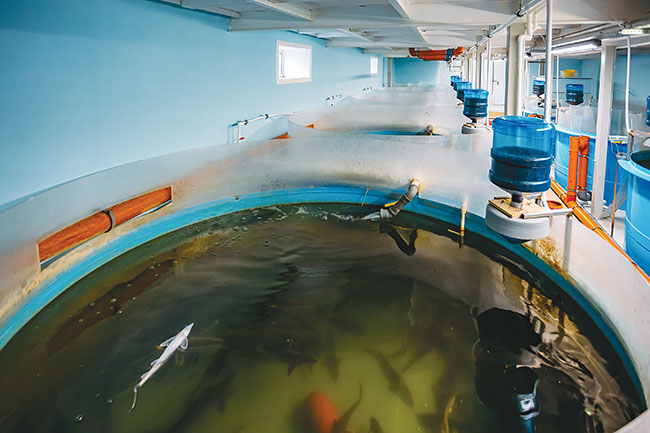
Having selected and set up the optimal automated feeding system, facilities must keep up on the day-to-day maintenance required to keep these systems working their best. Feeders do an excellent job of decreasing labour and increasing feeding efficiency, but they must be observed and maintained.
Technicians watching the fish or working at a tank, must also be watching the feeder itself and see it dispense feed. Regardless of the feeder type, it needs to be looked at each day for fouling, positioning, and overall correctness.
Cleaning
Cleaning feeders is one of the most important and often neglected jobs in maintenance because it is not very appealing. Feeding fish and foul weather get feed and feed dust wet, creating a mucky sticky paste that clings to surfaces. Wet feed dust builds up around feeder chutes and nozzles, spinners, and walkways resulting in an ugly mess. Wet feed attracts insects and soon begins to rot and mould, potentially falling into the fish tank. The feed itself, even when dry, will start to leave behind buildup on the walls of hoppers and chutes that should be removed from time to time. Accumulation around nozzles/chutes and inside the feeders can affect the ability of the feeder to dispense the proper amount and spread feed over the required area. The interval for cleaning feeders depends on type of feeder and application/facility, but regular inspections and maintenance should be scheduled. Feeders should be emptied and broken down to remove the buildup of dust and feed grime inside and outside. Underneath walkways and in nooks around tanks where feed can stick, rotting feed can build up as well so these areas should be identified and cleaned when possible. Rotting feed unfound will start to stink and mould in short order.
Calibrations
Calibrations are normal but extremely important procedures for centralized automated feeding systems and some non-centralized feed systems. Calibrating a feeder means making sure that when the feeder is set to feed 1 kg of feed, it feeds 1 kg of feed, not 0.8 kg or 1.2 kg. Losing feed calibration can be a huge pain for farmers, and potentially expensive. Playing out on a large scale at an intensive growing operation that dispenses tons of feed per day, uncalibrated feeders can mean overfeeding or underfeeding in a big way. If the feeder only dispensed 0.85 kg each time it should dispense 1 kg – an extreme example – one can see how the fish would be underfed.
This issue compounds if the feed software is sophisticated enough to grow the fish as well and starts to compute the size/growth of the fish based on feed they did not really receive because of the bad calibration. To be 15 per cent short of desired feed and not realize it can be a costly error, getting worse the longer the bad calibration is in play. To underfeed in a day is not the worst, but to underfeed for a week or two weeks is a serious amount of growth to lose.
Diligence of the technicians in observing and handfeeding can give the farmer a clue the feeder may be out of calibration if there are changes in appetite or a difference noticed in the amount of feed being dispensed. Another clue is inconsistency between the amount of feed loaded into the feeder per day and the amount of feed the control computer accounts as dispensed per day.
Feeders with a central control computer have a function to calibrate the lines/feeders or set the amount of feed. To calibrate, the feeder is set to dispense a known amount of feed manually, which is collected by the technician in a bucket or vessel. The feed is weighted to see the difference between the dispensed feed and intended dispensed feed. The correction is inputted into the system and the line is tested again. This continues – dispensing, collecting, weighing, inputting – until the feeder is dispensing the correct amount. Most facilities have a range (+/–) the calibration must fall within. The specifics of the calibration procedure, and how changes are made, depend on the feeder model. Some models that use selector boxes will have a dedicated calibration line to avoid collecting feed in a bucket over the tank.
Calibrations should be looked at as preventative maintenance. A good rule to calibration is to start with weekly calibrations and amend the schedule based on need. How often calibration is lost because of regular operation is dependent on the feed system itself, and the farmer will determine the best schedule. However, it is much better to do calibration (and less time-consuming) before the issue manifests itself significantly in over or under feeding. Other than regular interval calibrations, if the feed size is changed, or the blend ratio is changed, calibrate the feeder. When switching between feed brands of the same size, or even batches of the same feed brand with the same size, it is a good idea to calibrate.

photo: © thodonal / Adobe Stock
Feeding and hose maintenance
Centralized automated feed systems require a constant eye on the feeders and tanks, but the central units must also be maintained. Regular maintenance for the blowers should be in the maintenance plan, but the rest of the feed system needs to be inspected and maintained too. Feed dust, the ever-present enemy, builds up in the lines, chutes and the moving parts of the feed releasing system. If not cleaned, the line or mechanism will eventually plug or jam. Finding a good time to clean these systems at a production farm can be difficult because the feed system must be taken offline during the maintenance, and no one wants to stop feeding. Clogged lines, on the other hand, are much more problematic and take longer to clear than doing the maintenance. Before cleaning the mechanisms for your feeder, refer to the manufacturer or distributor for information on correct disassembly and cleaning. Obstructions in the feed line quickly create a huge mess as the line continues to back up with feed and must be cleared. Shaking or hitting the line with a mallet mat can clear some obstructions if the feed is not backed up too much. However, cutting or detaching the line, cleaning out the obstruction and feeding manually is often the only way. Make sure to de-activate the system when detaching the line.
Hose wear and feed breakage
The feed itself, when traveling to the tanks, will wear the lines and the lines will cause breakage on the feed. Plastic lines will wear out where the feed contacts the walls of the pipe. Wherever there is the most contact and force, the line will wear out first, namely bends and corners. The feed racing through the pipe to the tank contacts the pipe on the corners, slowly wearing it away until there is a hole right through. Depending on where this occurs, the feed spitting out of the line can be noticed and rough patched by staff until the entire line or section is scheduled for replacement. If left unnoticed, the hole will grow and more feed will be lost over time. Farmers fight this wear by choosing thick-walled pipes, using steel (an expensive option), and by having the fewest amount of turns and corners, and making the corners as gradual as possible.
Wear on the pipes is mirrored by wear on the feed. As the feed travels, particles break off the pellets where they contact the chutes and walls on the feed line. This feed dust is lost feed and, playing out over a year, it can be a significant amount of feed lost. Consider, if a farm feeds 1,000 tons per year and loses one per cent of its feed weight to breakage and feed dust, that is 10 tons of feed that did not get to the fish per year. Farmers minimize wear on the feed the same as on the lines – minimizing contact between the walls and the feed and making sure the blower is set to the proper speed.
As with all maintenance, it is better to do preventative maintenance of an automated feed system than deal with a problem down the road. What preventative maintenance looks like needs to be determined by the farmer using the feeder manufacturer’s info as a guide, and then deciding what else needs to be cleaned or maintained and how often. It is much better to perform maintenance to the feed system on a planned schedule than having to suddenly stop feeding at an unfavourable moment.
Print this page
Advertisement
- Women, youth dominate Tanzanian aquaculture scene
- $5-million grant powers aquaculture genetics research in Australia
 photo: © Mulderphoto / Adobe Stock
photo: © Mulderphoto / Adobe Stock 




